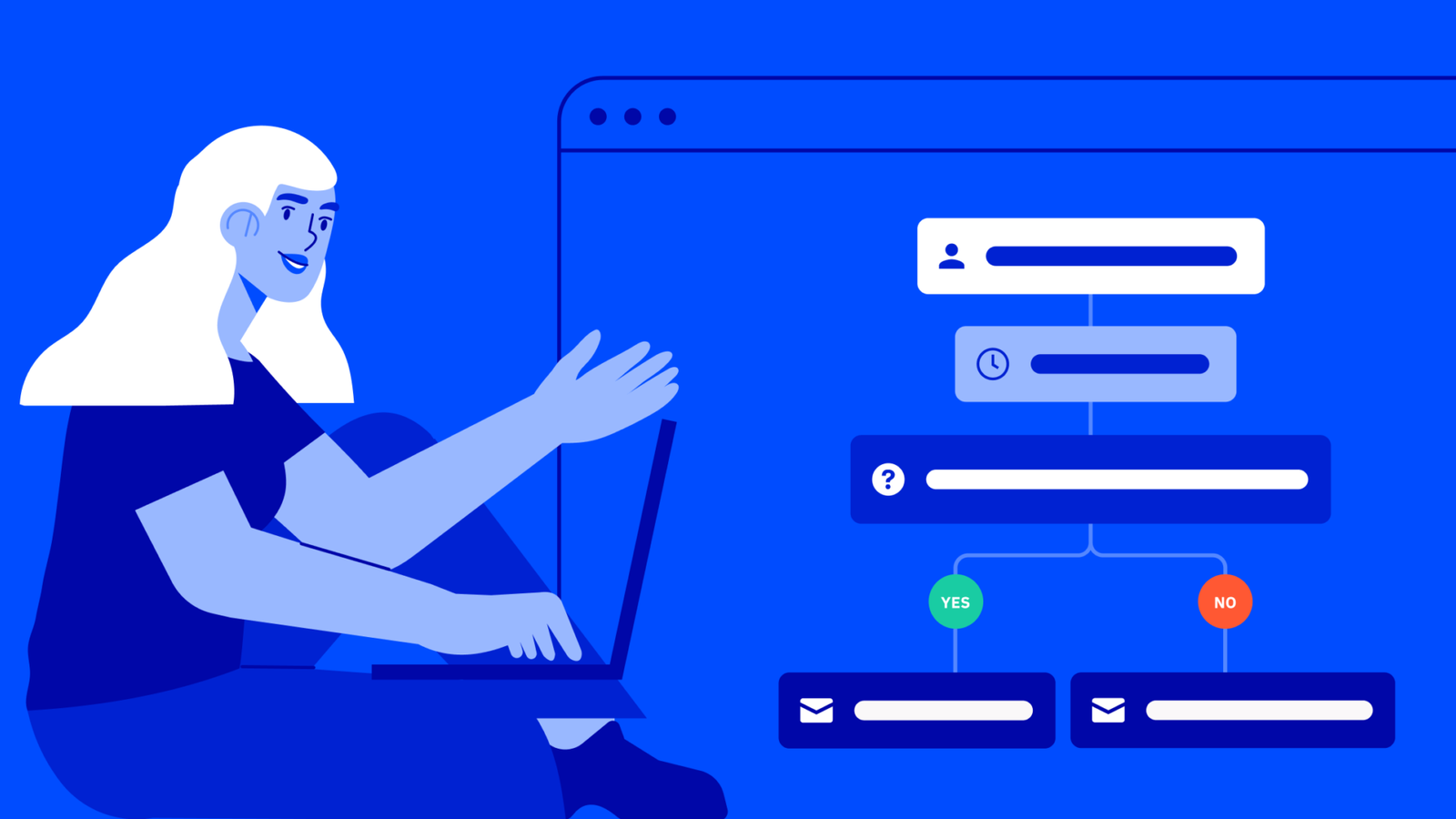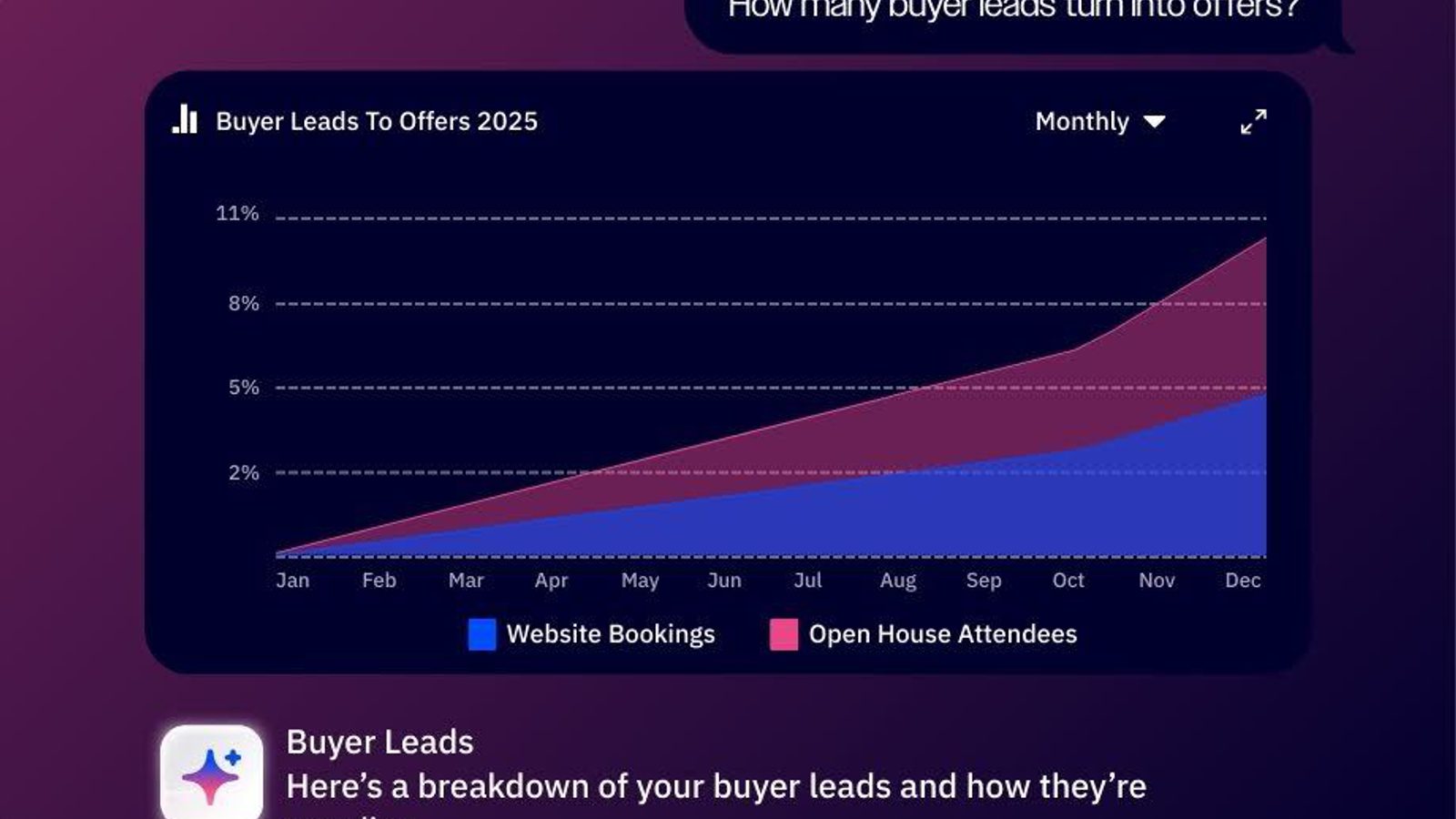A well-done, automated email sequence is what makes your revenue look good.

Get that paper (from a digital marketing channel!)
What’s an automated email sequence? We’ll get there in a moment but for now...
Imagine if you could keep all of your customers interested without lifting so much as a finger.
Well ok, maybe one finger. But only once in a while.
That’s automated email marketing in a nutshell. It works hard to send out an email sequence (or several) so you have time to focus on more fun things than hitting “Send” on repeat.
Email marketing produces the highest ROI out of most digital outlets – in fact, the average order value of a purchase from email is at least three times higher than one from social media, according to McKinsey.
In this post you’ll learn:
- What is an email sequence?
- 5 most important types of email sequences and how to handle them
- How to set automation goals for your autoresponder emails
What is an email sequence?
An email sequence is a series of emails automatically sent to specific segments of people on your email list. An email sequence can be trigger-based or time-based.
When an email sequence is trigger-based, emails are sent based on actions such as:
- Browsing behavior
- Subscribing to your list
- Shopping cart abandonment
- Reading or downloading content
- Buying a product
A time-based email sequence (sometimes called an email autoresponder) sends emails at predetermined time intervals, like…
- Right after opt-in
- 30 days after purchase
- On the anniversary of subscribing
You only have to set them up once. And then they work for you.
Email sequences are automated. They take people from not knowing your company to becoming full-fledged, enthusiastic customers (who just love to recommend your brand).
The 5 most important types of email sequences are…
- Welcome email sequence
- Onboarding email sequence
- Abandon cart email sequence
- Repeat customer email sequence
- Re-engagement email sequence
1. Welcome email sequence
When you go to someone's house, do you just walk in? Hopefully not. Of course not. They need to welcome you.
According to Omnisend, welcome emails have an average open rate of 45%.
Awesome! So how do you get those results from your welcome emails?
Do you make them personal? Do you try to start selling right away?
Expert insight: Tarzan Kay on selling with welcome sequences

“A lot of people think that welcome emails can’t sell something. I was even told once that you should send at least 12 nurture emails before selling something. I totally disagree.
What I teach my students is, before you write that welcome sequence, think about what you’re going to sell on the tail end of it.
You...
- Send a couple of nurture emails
- Slowly introduce them to who you are and what you do
- Share one or two of your core stories (make them emotional and really engaging)
- Start thinking about getting them to buy whatever thing you want them to buy
Ideally it’s connected to the thing that they opted in to get—because very few people will join a newsletter just to get a newsletter. For the most part they’re only signing up because you gave them a reason and they wanted to get your free thing.”
– Tarzan Kay is a conversion copywriter who specializes in launches and email sales funnels.
Saying “BUY THIS” in the first email is not going to go over as well. But a few emails later in the autoresponder sequence could be just right.
We recommend sending 4–6 emails as part of your welcome email series. You need to build trust and help your contacts out before you push for the sale—five emails give you space to devote each email to a specific topic.
Create your own welcome email series!
Conversion copywriter Val Geisler also recommends a 4-email welcome sequence strategy. She outlines it like this:
- Email 1: The Dinner Party Strategy (a warm welcome and some simple expectation-setting)
- Email 2: The Expertise Setter (show them the value)
- Email 3: The I-Make-Genius-Look-Easy Lesson (i.e., teach them to do what you do for your clients)
- Email 4: The Self-Segmenter (segment your subscribers and send them relevant emails)
Let’s take a look at the one that sets off the chain reaction – The Dinner Party welcome email.
Set expectations early (like Ben Settle)
When you’re walking into a new experience (like a dinner party with people you don’t know), you always feel a lot better if you know what you’re in for.
This welcome email example from email marketer Ben Settle does a great job of setting expectations.
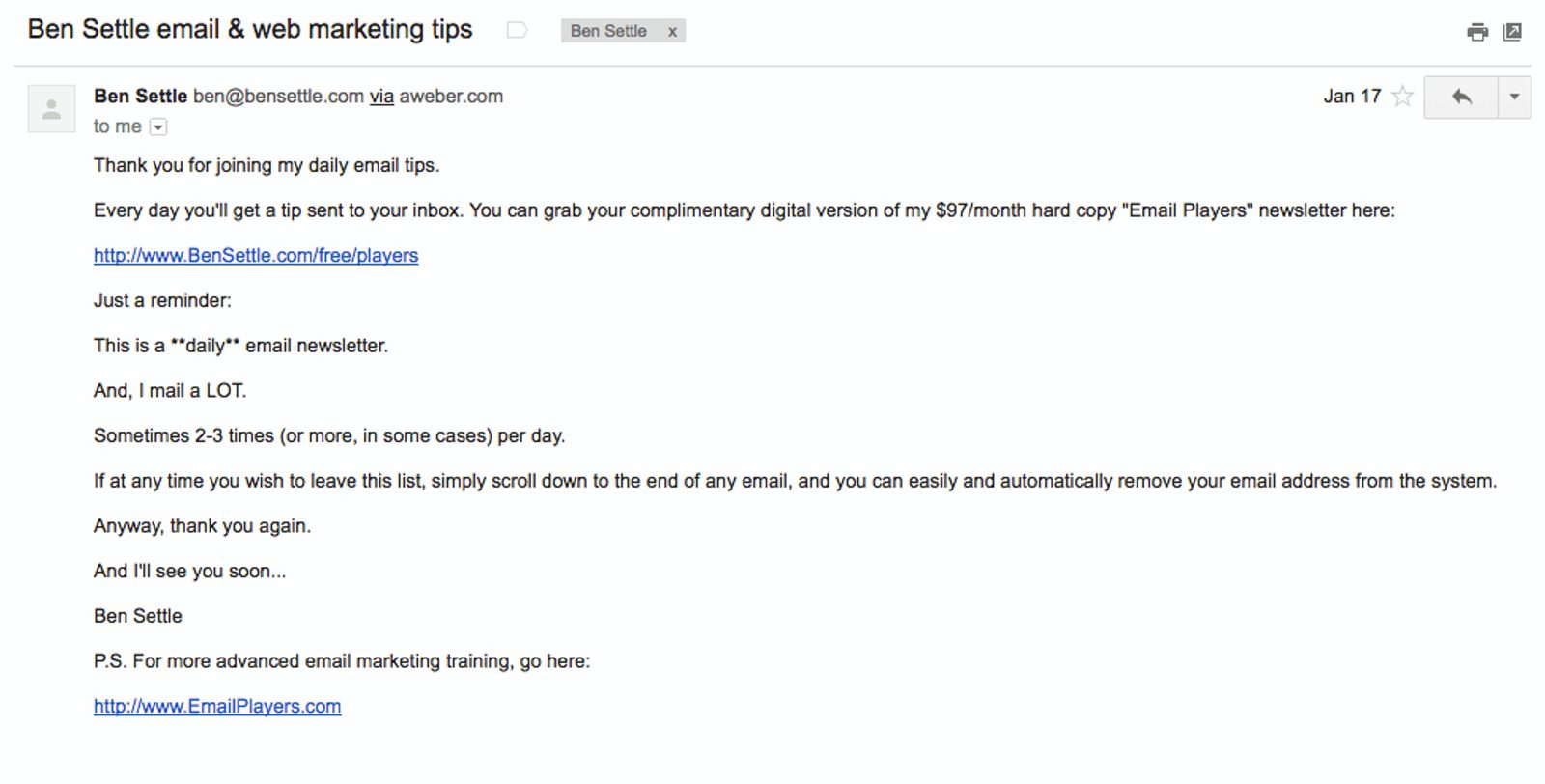
If you are planning to send daily emails, let them in on it.
They subscribed. They want to hear from you. But if you show up in their inbox repeatedly without warning (like a rude dinner party non-guest), that’s less fun.
2. Onboarding email sequence
You’ve welcomed them. Now don’t forget about them! It’s time to onboard.
When you onboard someone, you give them the information they need, keep them engaged– and ultimately get them to buy from you (or stick around for more)
This could mean having someone…
- Start a trial
- Use a product
- Book an appointment
To do that, an onboarding email sequence should include:
- Personalization
- Benefits over features
- The customer journey stage
Onboarding messages make sure your new customers understand how to use your products.
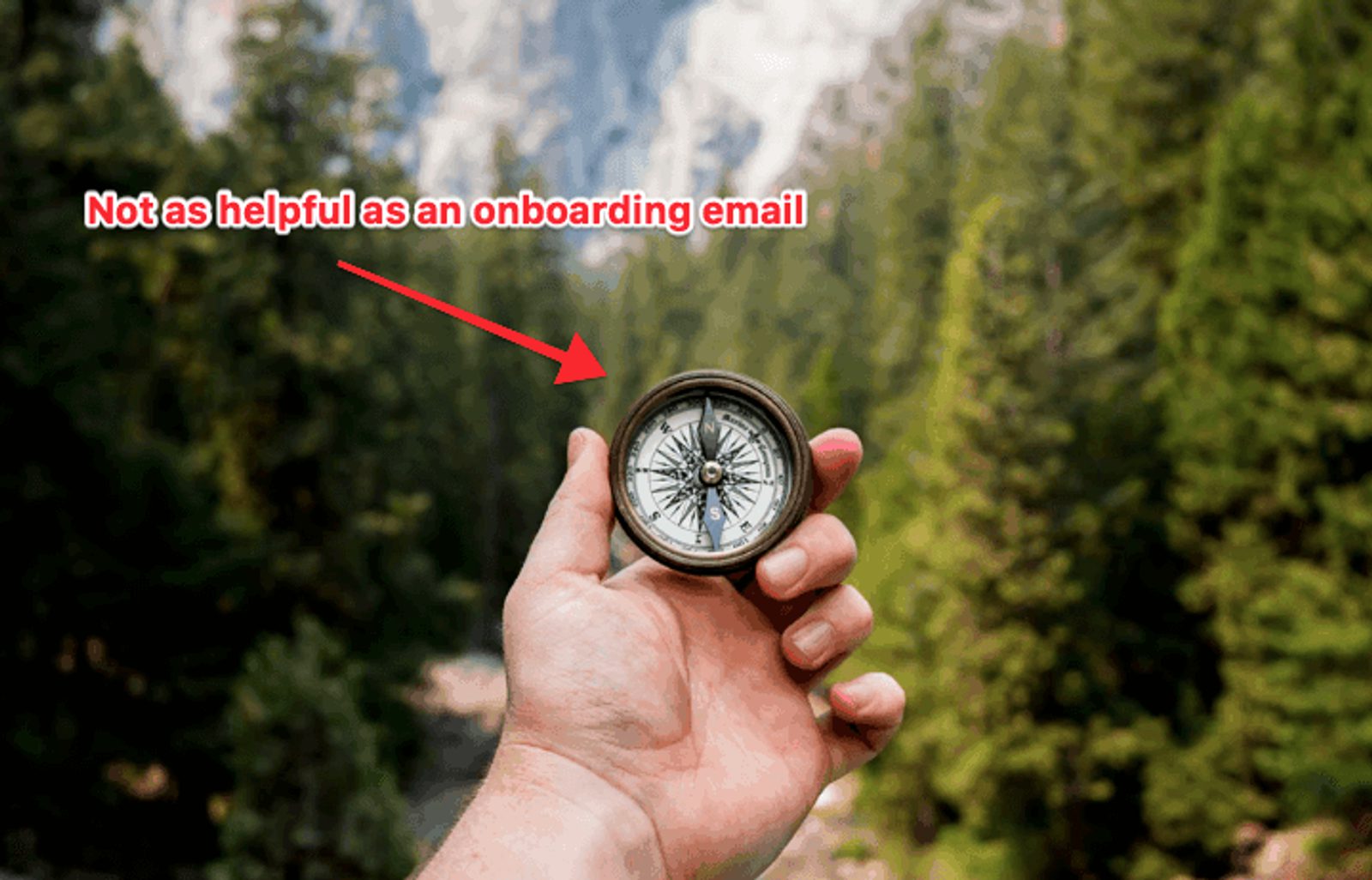
Actual instructions with this would be nice.
Here are a few tips we recommend for onboarding emails.
- Focus on the value, not just the features. People don’t buy your product for its shiny features – they buy to solve a problem. So the way to convert your new friends into new customers is to emphasize what benefits your product will bring to them. Your product can still be pretty and shiny, but that’s not your selling point.
- Give social proof. In Robert Cialdini’s book, Influence: The Phsychology of Persuasion, he writes “We view a behavior as more correct in a given situation to the degree that we see others performing it.'' People decide what to do based on what other people are doing.
It’s social proof, and using it in marketing can be extremely effective. Include relatable customer stories and product testimonials to encourage new subscribers to buy.
- Don’t just ask – incentivize. A welcome email series is not the time to be hard selling your customers, but you can be more creative in your onboarding series. Offering a first-time purchase discount can be all the push a customer needs to convert.
Show people exactly what they need to do
Brooke Kalisiak, a specialist in pelvic health, knows that taking the first step for physical therapy can make you nervous.
You might also be uncertain – because you aren’t quite sure what kind of progress is possible and you’ve never met your physical therapist.
So Brooke’s welcome series specifically addresses patient fears and builds trust.
Here’s what she puts in her onboarding email sequence.
- Basic appointment information. Step one is to make sure patients have everything they need for their appointments. That means a reminder of the date and time, (and the clinic’s location).
- An intro to their therapist. Just knowing who will treat you is a big comfort. This email has a picture of the patient’s therapist, along with some info about their qualifications.
- Pictures of the clinic from the outside. It sounds small, but everyone is a bit nervous about getting lost when they go somewhere new. Finding it. A picture of the clinic eases that fear.
- Testimonials based on their condition. By using tags to segment her contacts, Brooke can send testimonials from past patients—who were treated for the same condition as the new patient.

It’s reassuring to know who you’re going to work with
This automation isn’t complicated. But at each step, it addresses the anxieties that all new patients come in with—even ones as small as knowing what the clinic looks like.
Move people from questioning to sold (like Wistia)
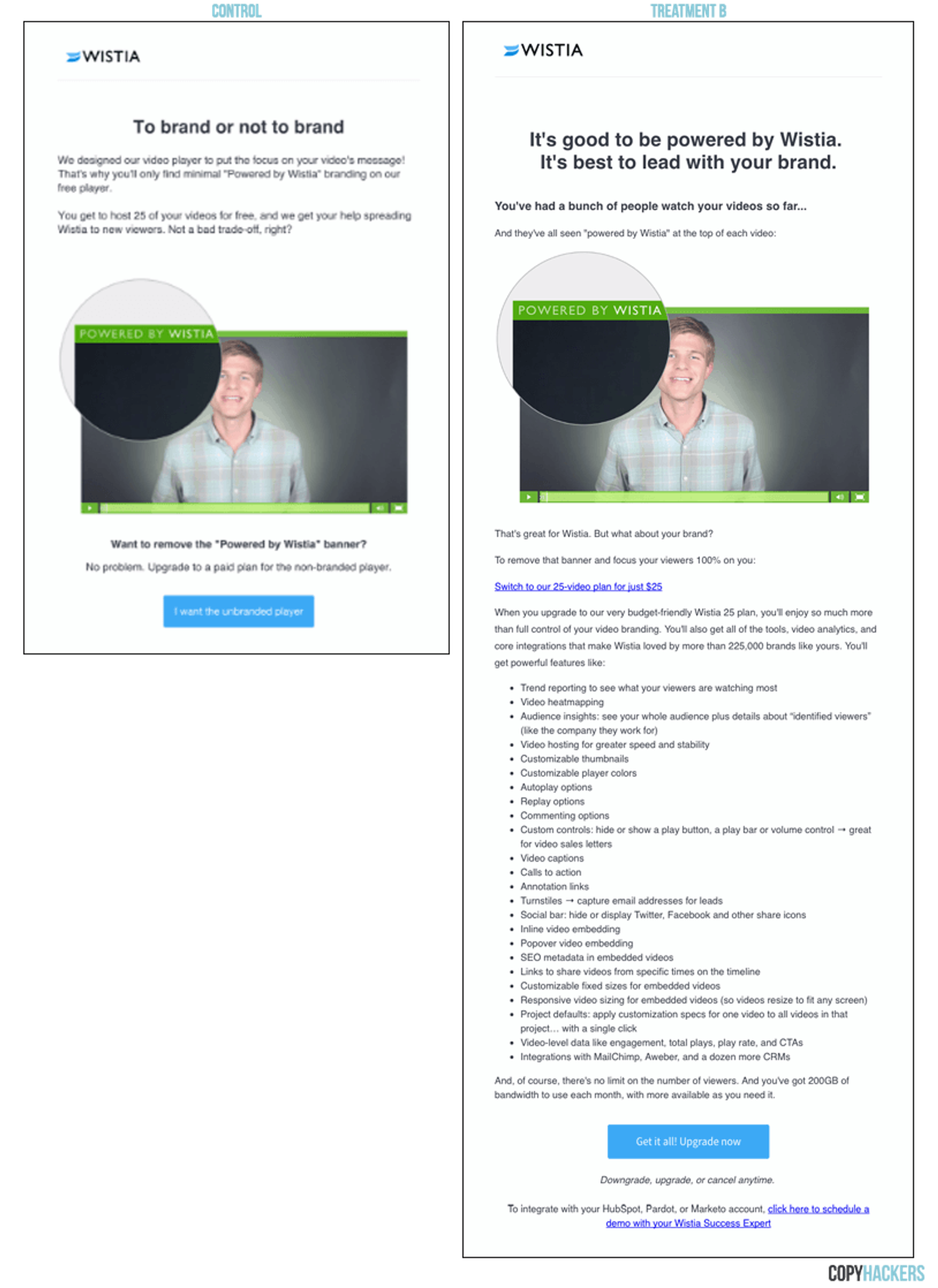
(Source: Copy Hackers)
The biggest takeaway from this onboarding email is that guides people from problem aware to most aware.
A paid conversion happens once you’ve moved a prospect through the 5 primary stages of awareness, all the way to Most Aware.
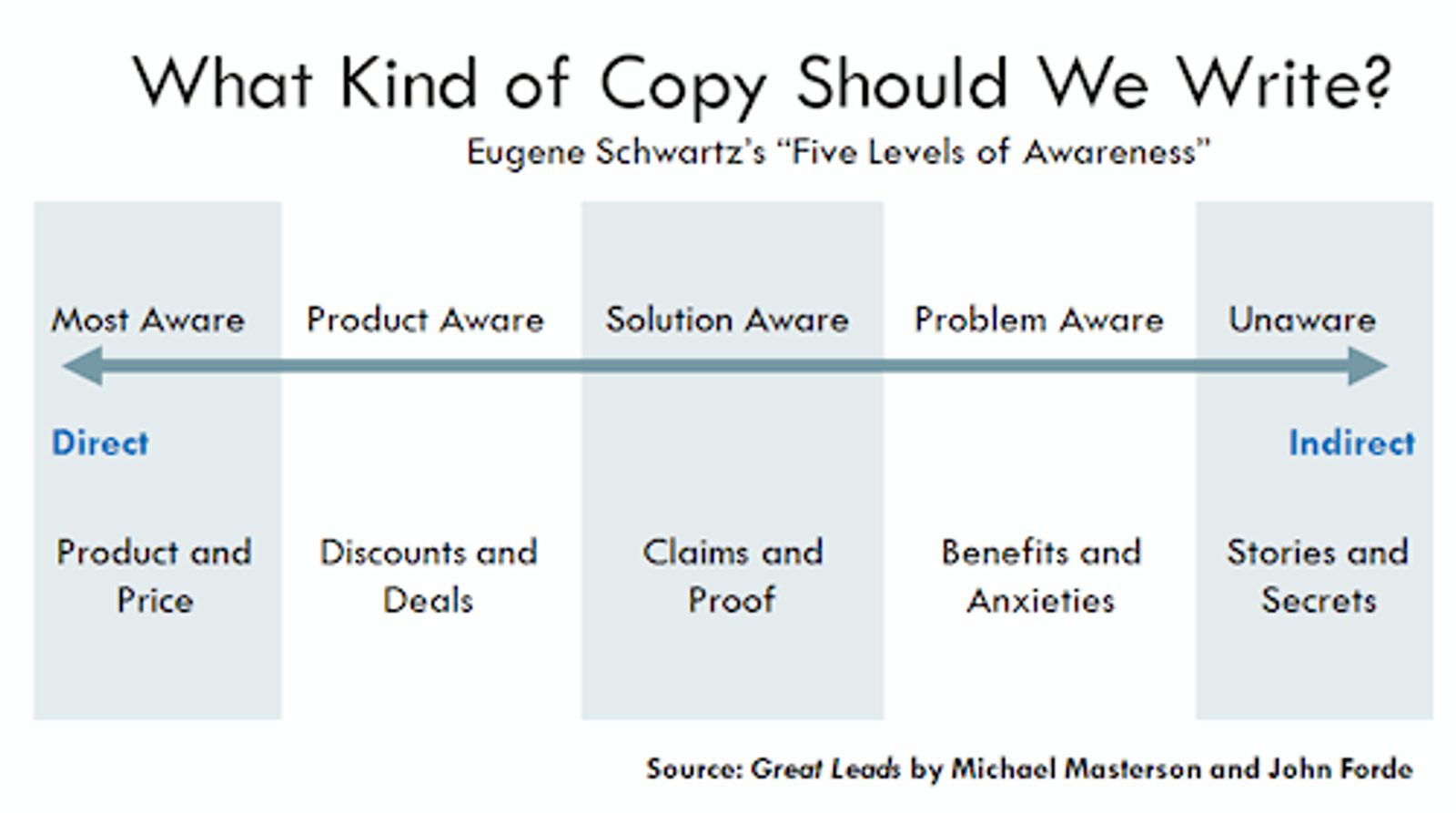
By the time a trial user started to receive the emails in the Wistia sequence, there was good reason to believe they had strong Product Awareness and were moving toward Most Aware. The goal of the Wistia email sequence was to move the prospect from Product Aware to the far end of Most Aware, where closing happens.
Optimizing your email sequence to get a paid conversion might mean reordering your existing emails along the stages of the awareness spectrum.
One other takeaway? The length.
What’s great about this longer email is that it takes time to develop a good argument, make the case, and close the deal. It looks like a lot to read, but what you’re reading is quality information.
True, longer emails can be a risk because it could take longer for people to see your CTA (or they might not bother looking for it at all). But if your email is really good, they will (the 3.5x improvement to Wistia’s conversion rate is proof).
3. Abandoned cart email sequence
Why do 77% of carts get abandoned?
People can visit your site, browse around, fill a cart – then get hungry, close their laptop, go make a sandwich, and forget everything.
Or they could abandon their cart because:
- Your payment process doesn’t look secure
- There are too many steps to the checkout process
- They were just browsing and filling their ideal shopping cart for fun (I totally do this)
- Their cart is too expensive
Whatever the reason, you need a way to get at least some of those customers back.
Business Insider said that online retailers will lose as much as $4 trillion to cart abandonment.
That’s trillion. With a “T.”
But the good news – those retailers can recover about 63% of that lost revenue. Hallelujah for the abandoned cart email sequence.
A good abandoned cart email sequence uses at least 3 emails.
- Email 1: The first reminder – sent after 24 hours
- Email 2: Addressing possible objections – sent after 48 hours
- Email 3: Incentivize them with a discount – sent after 72 hours
If you think you need more emails, go for it! Just be careful not to be too pushy.
Here are a few abandoned cart email examples we love.
Appealing to emotions (like Dote)
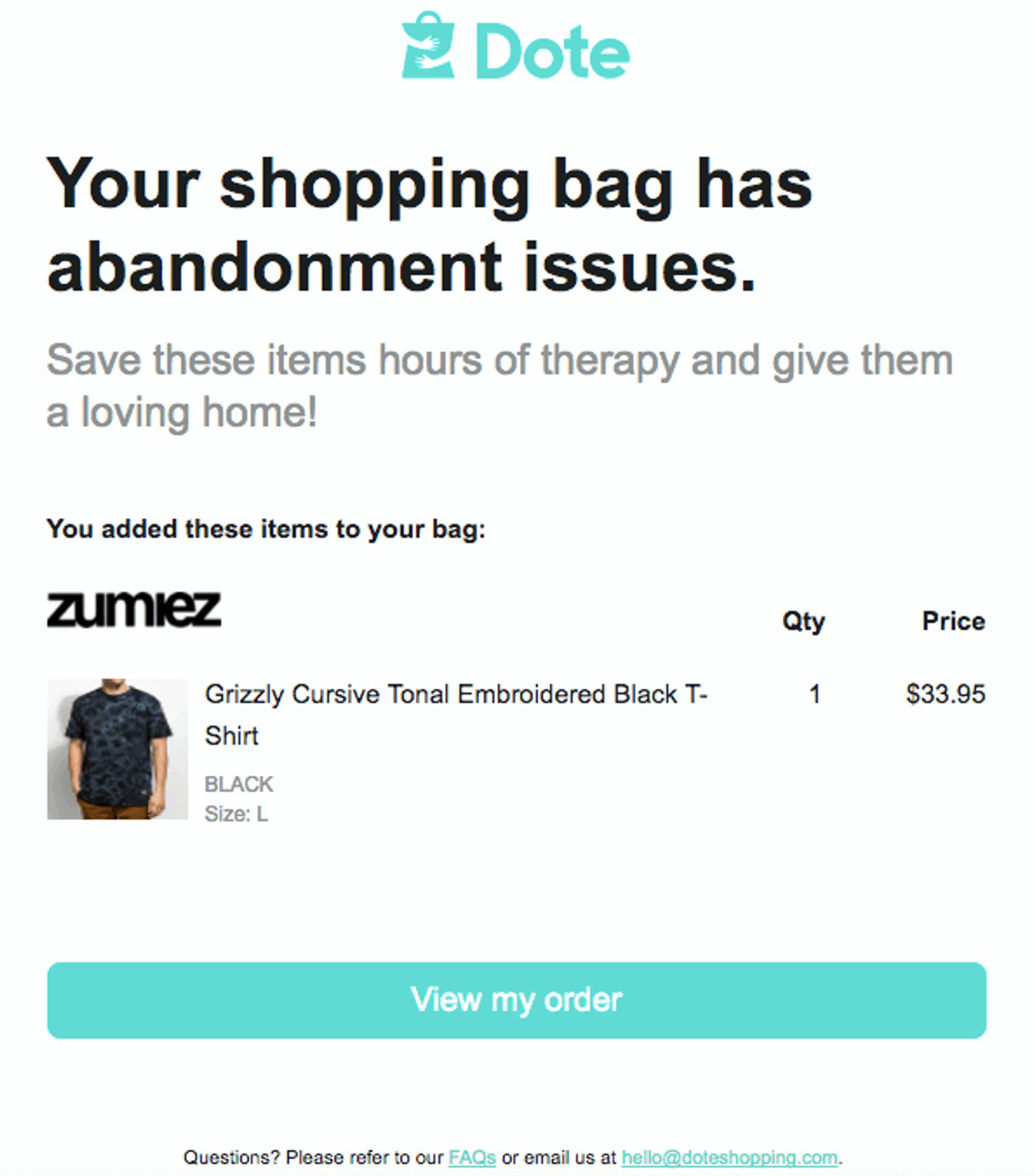
No one wants to be abandoned, and no one likes to be accused of abandoning. Dote targets that guilt with this powerful autoresponder email copy.
One other thing we love about this email is that it shows the physical product about to be abandoned.
It’s easy to ignore an abstract idea because there is nothing about an abstract concept that you have to face head-on. Putting the product in front of them helps them imagine what it would be like to have it, and reminds them of why they wanted it to begin with.
Keep it simple and clear (like 23andMe)

Have you ever had someone catch you at the last minute and say “Hey, don’t forget that”?
This 23andMe abandoned cart email does the exact same thing. They keep it short, simple, and direct.
Recommend other products (like Brooklinen)

Brooklinen gives a compliment and a free shipping incentive, plus extra recommended products to make revisiting that abandoned cart even more enticing.
I do need to call out a few things about that last bit – adding product recommendations.
These are often included in a triggered email like this, and they can definitely help customers add an additional product to the order (and increase the order value). But they can also lead to a deleted email in some cases. To avoid this, make sure you:
- Use only one CTA. One is typically preferred to minimize distraction from clicking through.
- Check that the included products are not out of stock (to the best of your ability)
- Check that all product info is correct from name to price (especially if it’s included in a sale)
- Recommend only non-purchased products
4. Email sequence for repeat customers
Return customers annually spend 120% more than new customers.
When you focus on getting new leads, it’s easy to forget your repeat customers.
Did you know that even though repeat customers only makeup about 11% of your customer base, they pull in almost a quarter of your revenue?
The thing is, they won’t stay repeat customers if you ignore them.
And they could need a little coaxing to come back.
Here’s how to send repeat customer emails:
- Email One: Check in 2-3 days after they should have received their purchase and see how they felt about everything.
- Email Two: Send another 4 days after that with something useful, such as product recommendations or recently published content they would enjoy.
Check on their experience, then upsell and cross-sell (like Chewy)
Pet supplies business Chewy checks in shortly after people receive their orders.
Here is an example of the first type of repeat customer email that Chewy sends at the 2-3 day post-delivery mark.
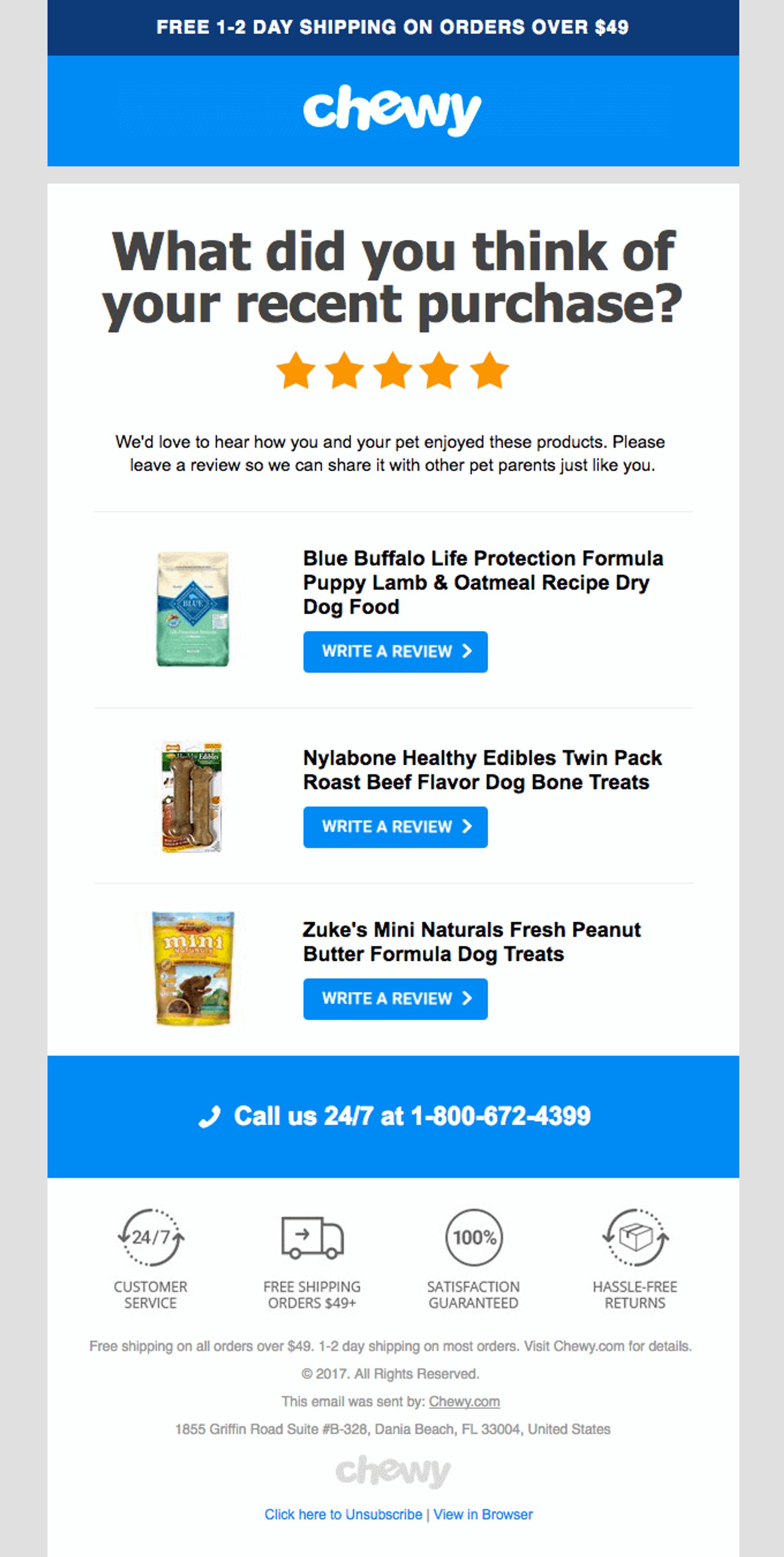
Asking for feedback can also help you send better emails in the future.
Here’s an example of a second repeat customer email that is sent later on.

Have you ever heard of trip-wire marketing?
Trip-wire marketing is getting a customer to buy a smaller or more inexpensive product from you to ensure repeat customer retention going forward.
The idea is that once people have bought even an inexpensive item from you, they are more likely to purchase something else.
Why?
Veteran online marketer Frank Kern says that people are suspicious of an outright free offer and look for the catch, whereas a lower-cost offer tends to convert better because it helps to alleviate that suspicion.
Drew Sanocki, the CEO of AutoAnything and former CMO of Karmaloop,, talks about how tripwire marketing really helps retain repeat customers and increase profitability.
How does he know it works? Because in the span of 3 months, tripwire marketing turned his friend Ron’s almost-failed business into a profitable, stable brand.
In tripwire marketing, you trigger your emails based on what your customers do. If someone hasn't bought from you in 45 days (but they usually buy every 30) it's a good time to market to them.
You can set your 'tripwires' based on anything you think is important.
According to Drew, it only takes 3 steps to see profitability from lapsed repeat customers.
- Modeling desired customer behavior
- Flagging deviations from that behavior (i.e., the “tripwires”)
- Focusing your marketing time and energy on correcting those deviations
Drew shares his own example of how this works:
“Every Friday I work out at Slow Burn Fitness on the Upper West Side of Manhattan.
That’s my “standard behavior.” This is Step #1.
After several months of this, I stop. Maybe I found another gym or just got too jacked (less likely) or just got too lazy (more likely).
There’s my deviation. This is Step #2.
I’ve just “tripped a wire”: Slow Burn notices that I’m not coming in anymore. They send me a “Come back and your next workout is on us!” coupon. This is Step #3.
I receive the coupon, feel guilty, and start hitting the gym again.”
Repeat customers will repeat their buying behaviors again with the right email marketing.
5. Re-engagement email sequence
What is a re-engagement sequence?
A re-engagement campaign is a sequence of emails sent to past customers to “win them back” after they have stopped interacting with a brand over a certain length of time (such as 30-60 days after their last interaction).
It’s cheaper to re-engage old customers than it is to find and nurture new ones.
In fact…
- Acquiring a new customer can cost five times more than re-engaging an existing customer
- Increasing your customer retention by just 5% can increase profits by 25-95%
- You can see 60-70% more conversion success selling to an existing customer as opposed to 5-20% success selling to a new one
Does this mean that you shouldn’t focus on finding new qualified leads? Of course not. But you should definitely have a strong re-engagement campaign.
Only send 2-3 re-engagement emails. These are not brand-new customers who need a ton of information. They just need a few helpful reminders to nudge them into action.
Shine a light on their progress (like Teespring)

Just TRY to ignore this puppy and their email. Go ahead, I dare you.
What we like about this email (besides that heartbreakingly, adorable puppy) is that Teespring just tells you that they miss you – they tell you why you should miss them.
- “You’ve sold 214 products or $6016.39 in total sales.”
- “You’ve also averaged a 50% overall success rate.”
Teespring is offering proof that working with their brand was a good idea. Want to re-engage a quiet audience? Remind them of their past success.
NOTE – Don’t remove people from your list just because they don’t respond to your win-back campaign right away. Give them a little time.
But if they do stay quiet, don’t stress. List cleaning is good for everyone – it makes room for people ready to be connected with you, and it improves your deliverability and open rates over the long term.
Conclusion: Set goals first, create goal actions after
We’re going to state the obvious here. If you want an automated email sequence that works, start with a goal.
What do you want your automations to accomplish?
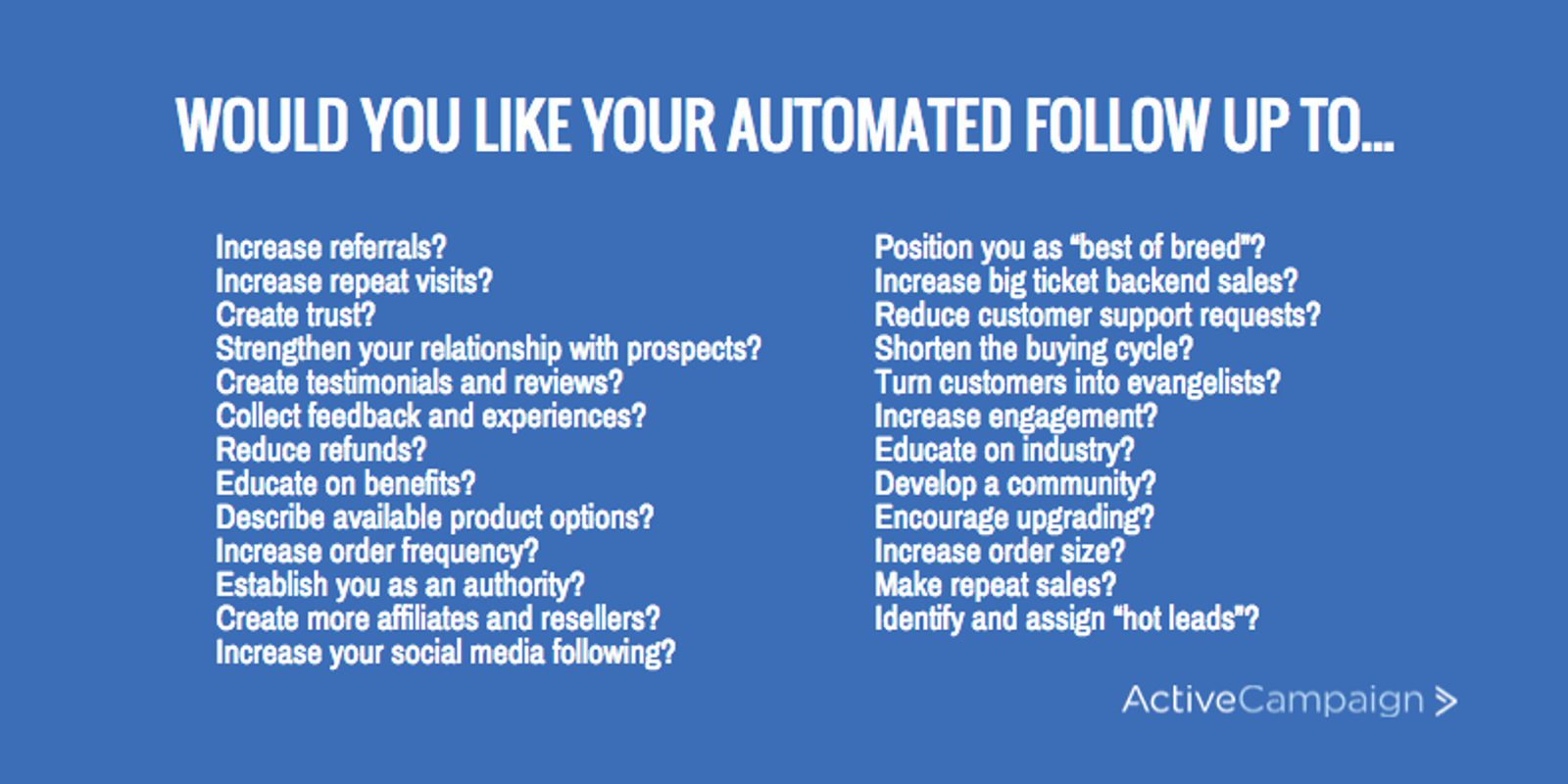
Probably a lot of these, right?
Automations are helpful, but they aren’t mind-readers. You still have to control what’s going to be automated – and know why you are automating it.
You don’t need to know exactly what each automation will look like (that’s next). Right now you’re just making your follow-up goals wish list.
Once you’ve got your list of goals, separate them into two categories:
- Pre-sale: Automations designed to turn prospects into customers
- Post-sale: Automations designed to turn customers into repeat customers
After you pick your automation goals, create your action lists to achieve them.
“Increase engagement” by…
- Emailing new blog posts (with RSS to email)
- Asking what content they want
- Incentivizing social media follows
“Increase repeat sales” by…
- Sending info on a rewards program
- Giving ‘customer only’ discount (20 percent?)
- Notify of bi-weekly sales
“Increase order size” by…
- Send a ‘one-click upgrade’ offer immediately
- Buy-one-get-one offer on accessories
- Suggest complimentary products (3-5)
Put a lot of effort into brainstorming all the ways you could accomplish these goals, and don’t limit yourself. You never know what might come to mind.
And once you’re ready to create an email sequence, consider using pre-built automation recipes and email templates to take some automation work off your hands.
Here is a cart abandonment email automation recipe (that you can actually use in ActiveCampaign):
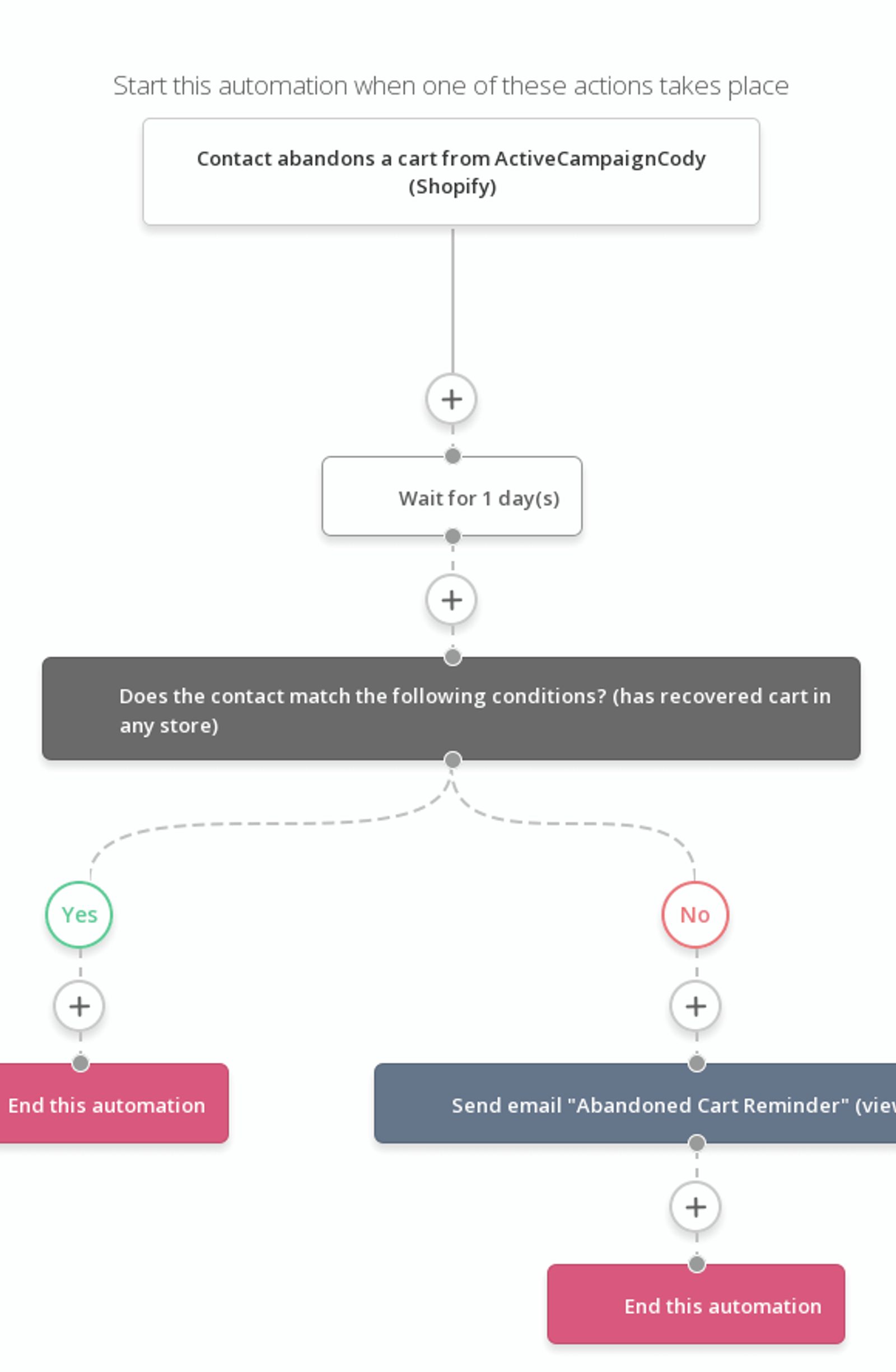
Automated email sequences make your everyday marketing life so much easier.
What are you waiting for?

